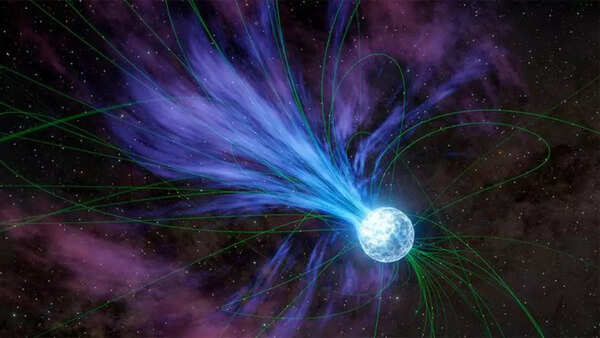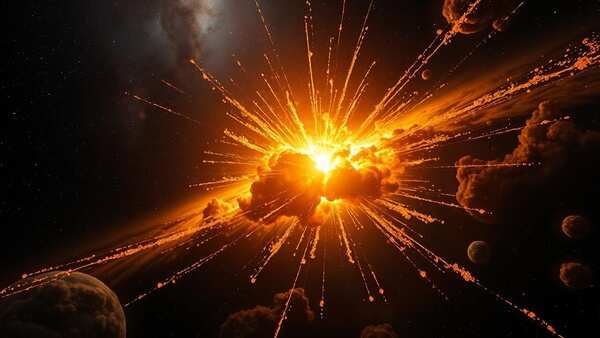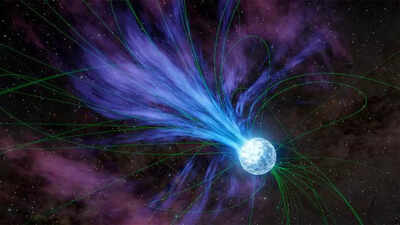The Akshaya Tritiya, an annual Jain and Hindu spring festival, is almost here, and what’s a more fitting occasion than this to dig deep about gold? Where did your gold earrings come from? Of course, from the store! But, before that? Where were they sourced from? Yes, gold mines. But how did it emerge there? How did they form on Earth? Well, NASA’s data may have some clues to offer. What if we tell you that some of the gold in your jewellery or smartphone (yes, your phone has gold in it) might have been made in a magnetar explosion billions of years ago! Sounds wild, but it’s possible.

Where does gold come from?
We know that hydrogen, helium, and a scant amount of lithium have existed in the universe since the Big Bang. The heavier metals were formed later, as the stars fused lighter elements into heavier ones (up to iron) in their cores. However, how the first elements heavier than iron, such as gold, get created and distributed throughout the universe remained a mystery. A new study by researchers at the Flatiron Institute’s Center for Computational Astrophysics in New York suggests some cosmic connection! Using 20-year-old archival data from NASA and European Space Agency telescopes, researchers have found evidence that powerful flares from magnetars could account for up to 10% of elements heavier than iron, including gold. The findings are published in The Astrophysical Journal Letters.

The new study found that a single giant flare from a magnetar can produce the mass equivalent of 27 moons’ worth of heavy elements, including gold, platinum, and other heavy elements. These elements, which include uranium and strontium, are produced in a set of nuclear reactions known as the rapid neutron-capture process, or r-process.
“This is really just the second time we’ve ever directly seen proof of where these elements form (the first being neutron star mergers) study co-author Brian Metzger, a senior research scientist at the CCA and a professor at Columbia University, said in a statement. “It’s a substantial leap in our understanding of heavy elements production.”
The researchers have unraveled a puzzle dating back to December 2004, when a space telescope detected a bright burst of light from a magnetar. The initial giant flare was so intense that it released more energy in a few seconds than the sun does in a million years. Though the astronomers quickly identified the flare’s origin, a smaller signal that appeared 10 minutes later remained unexplained until now.

In 2024, Metzger and colleagues calculated that the giant flares could eject material from a magnetar’s crust into space, where r-process elements could form.
“It’s pretty incredible to think that some of the heavy elements all around us, like the precious metals in our phones and computers, are produced in these crazy extreme environments,” Anirudh Patel, a doctoral candidate at Columbia University and lead author on the new study, said.
They found that giant flares from magnetars create unstable, heavy radioactive elements, which then break down into stable ones like gold. As this decay, they emit a glow of light and form new elements. In 2024, the group also calculated that this glow would appear as a burst of gamma rays, a form of highly energized light. When they shared this with gamma-ray astronomers, they discovered that a similar unexplained signal had been seen decades ago. As scientists studying magnetars and those studying element formation rarely work together, no one had previously suggested that the signal might be caused by new element creation.
“The event had kind of been forgotten over the years. But we very quickly realized that our model was a perfect fit for it,” Metzger says.
“The interesting thing about these giant flares is that they can occur really early in galactic history. Magnetar giant flares could be the solution to a problem we’ve had where there are more heavy elements seen in young galaxies than could be created from neutron star collisions alone,” Patel adds.
The researchers are hoping to observe more such flares to understand the contribution of magnetars. NASA’s Compton Spectrometer and Imager is expected to launch in 2027, and it could help capture these signals.
“Once a gamma-ray burst is detected, you have to point an ultraviolet telescope at the source within 10 to 15 minutes to see the signal’s peak and confirm r-process elements are made there. It’ll be a fun chase,” Metzger says.
The next time you wear your gold jewellery, thank the universe!
